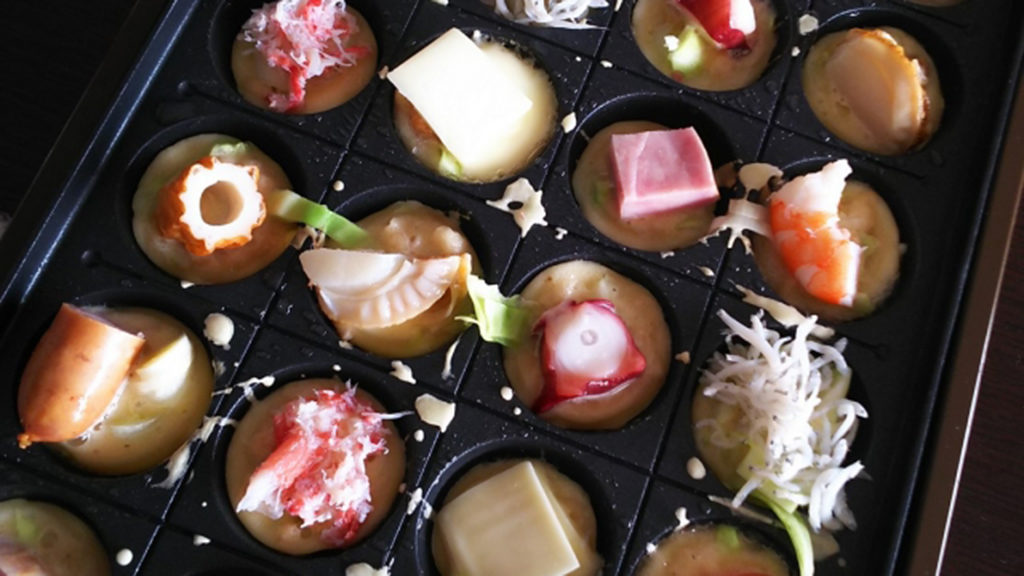What is Takoyaki? Its Origins and How to Make it

This post is also available in 日本語
“Takoyaki” is popular as a fast food that can be eaten on a casual basis. This is a type of food that originates in Osaka, but is eaten throughout Japan. You can purchase this in many stores, and it is also made and eaten in the home. Recently, we have seen the emergence of “Takopa”, home parties where “Takoyaki” is eaten. On this occasion, we will introduce you to Takoyaki.
Contents
What is Takoyaki?
Foods that use flour, such as “Okonomiyaki” and “Udon” are known collectively as “Konamon”. Takoyaki is one of these “Konamon”. A bitesize piece of octopus with some seasoning is placed on a base made of flour and eggs, and made into spheres of approximately 3-5cm. These are made on “teppan” plates with round hollows called a “Takoyaki maker”. In Kansai, mainly in Osaka, flour food culture is particularly loved, and Takoyaki are used not only as a snack, but for lunch or dinner as well.
Origins of Takoyaki

In the beginning of the Showa era, the original Takoyaki shop called “Aiduya” appeared in the Nishinari-Ku, Osaka City. “Radio-yaki”, which included not only octopus, but beef sinew and “konyaku”, was the precursor to Takoyaki.
On the other hand, in Akashi, Hyogo Prefecture, there are the dishes of “Akashiyaki” and “Tamago-yaki”. Flour, wheat starch, eggs, and octopus are baked into spherical shapes, so are similar in this regard to Takoyaki, but they are fluffy and light, and eaten with soup stock.
Aizuya used this Akashiyaki as a hint when adding octopus (tako) and named it “Takoyaki”.
Takoyaki maker
Takoyaki makers used in the home consist of the desktop electric type, which are like a hotplate, the desktop type like a cassette gas stove, and which can be used and the “Teppan” type that can be used either on the desktop or in the kitchen. Items with a strong flame, and where the “Teppan” section can be removed would be recommended. These can also be obtained from Internet shops, such as Amazon or Rakuten, or home centers.
Method of making Takoyaki that is unlikely to fail
- Prepare the ingredients
Cut the octopus to a chunk of approximately 1cm, and add finely-chopped red ginger, and green onion as condiments. It is convenient to mix in ingredients other than octopus. - Create the base
Originally, this was created by mixing flour with soup stock, egg, and soy sauce. If you use off-the-shelf “Takoyaki flour”, you can make the base just by adding eggs and water. First mix the eggs and water well with a whisk to make it easier to mix. - Heat the Takoyaki maker well and paste oil over not only the hollow sections but the whole plate. Use a ball of kitchen paper to make sure this is applied evenly, and brush using an oil brush. It is a good idea to use a fair amount of oil.
- The base can easily get separated, so pour the paste into the grooves while mixing thoroughly. Fill up to about 70% of the groove.
- For each groove, place one piece of octopus in, and place the prepared seasonings over it. You can put “Tenkasu” (Tempura crumbs) or Sakura-ebi(shrimp) as well to taste. Tenkasu are the crumbs made when frying tempura, and these are sold commercially.
- Once the ingredients have been heated, pour more base in so that it slightly overflows the hollow.
- Once the outside has become white and hardened, place a skewer next to the section overflowing from the hollow. Then skewer the Takoyaki overflowing from the Takoyaki maker and turn it upside down.
- Keep turning every now and then so that the color becomes even.
- Once they have been placed on a plate, pour on sauce, and “aonori” (seaweed), Katsuobushi (bonito flakes), and mayonnaise to taste. Sauce for Takoyaki is sold commercially. Soy sauce and “Ponzu” sauce can also be added to taste.
Different types of Takoyaki

More and more people are using Takoyaki makers to enjoy different types of ingredients other than octopus. Popular ones include “mochi”, “kimchi”, squid, and shrimp. You can put small “onigiri” rice balls in and enjoy “Yakionigiri”. You can also use hot cake mix powder to make small desserts, such as mini donuts. You should try a wide variety of things.
- What are “Wagara (traditional Japanese patterns)”? Meaning and Prayers Accompanying the Main Japanese Patterns
- Types of Sushi and Its History
- Easily Explained. What is “Furusato Nozei”?
- Katakana words, what do they mean? “Icons, remote controls, computers…”
- [2021 | Tokyo] Four Japanese language schools recommended









